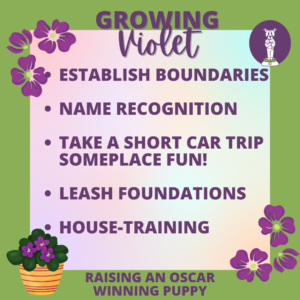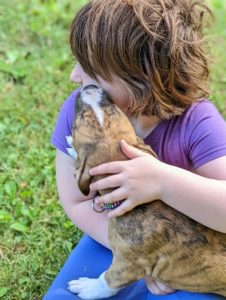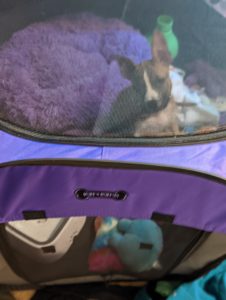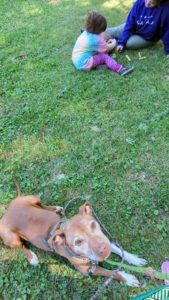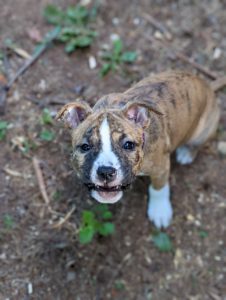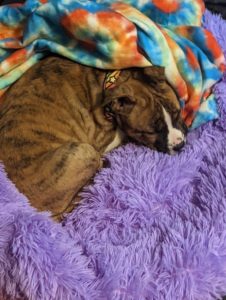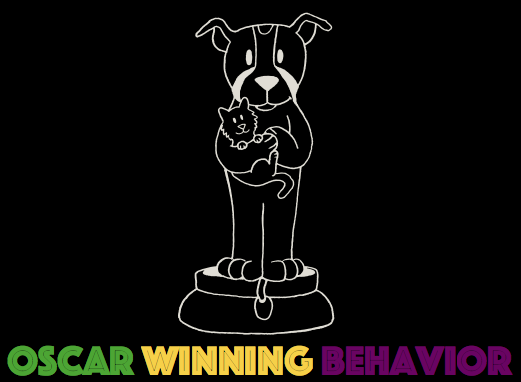The first part of having a new puppy in your home is getting to know each other a bit.
You’ll want to teach them that you are safe, and can be trusted, and you’ll want to spend a little time getting to know what sort of toys they like, what their schedule is, and what makes them tick.
It’s not about demanding respect or putting them in their place – it’s about learning about your new partner!
Once you’ve picked their name, be sure to use it positively. That means if they’re getting into something they shouldn’t, or going potty in the house, or chewing on something, or biting at you with those little needle teeth, try not to say their name. But play time, snuggles, doing something good, and delivering treats all get lots of use of the name.
A great exercise to get pup used to turning to you when they hear their name is a variation of the “Whiplash” Pattern Game, developed by Leslie McDevitt. You’ll start by putting a treat on the floor and letting pup eat it. While they’re chewing, move two or three steps behind them. The instant they’re done the first treat, say their name. Chances are just the sound will get them to turn to you, in which case you’ll praise gently and put another treat on the ground, repeating the action of moving behind them and waiting for them to finish the treat. If they sniff around looking for another goodie before looking to you, that’s okay. Just wait patiently until they look, then praise that and put another treat down. Before long, they should hear their name and turn to you eagerly!
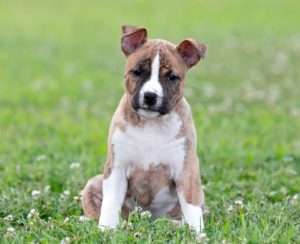
Boundaries are important, always, and it’s good to remember that it’s much easier to loosen up on boundaries later than it is to tighten them. So, for example, if you think there will come a time when you don’t want your pup on your couch, or in your bed, make that the rule now. If you’re sure they’ll always be allowed these places (as mine are!) feel free to let them up from the start! It’s a good idea also to set up a crating area that is all theirs, and figure out where you’ll want them to be during regular activities at your house – like when you’re busy in the kitchen, doing office work, or otherwise focussed on non-puppy things. The sooner you can set them up for success at these times, the better chances their adulthood will be completely routine, and you won’t have to worry!
This can actually be the start of your crate training – if puppy can’t be directly under your observation, they should be confined safely with something to do. Violet is in a small exercise pen (lidded, so she can’t get out on her own) with a bed that she likes, a no-tip water bowl and several toys of different textures and materials (I’ll also be cleaning this pen out and rotating toys once a week, so every Friday the toys in with her get put back in her toy basket, and different ones are given to her.) This is the start of puppy learning to be okay on their own, learning to self-entertain, and to settle when you aren’t with them. But most importantly, it keeps them out of trouble.
Each time they’re crated or away, the very first thing you should do when they are released is give them a potty break – carry them out if you have to in order to keep them from being distracted by… lint and other puppy thrills. A good rule of thumb to follow is that however many months old your puppy is, that’s how many hours they can go without a potty break. So at just over two months, we’re taking Violet out every two hours. Outside she gets to sniff and explore (we have a fenced back yard, but we’ve also done this on leash in the front yard) and gets praised for going potty. Once she’s gone potty, we let her sniff and play some more – this part is important. If puppy wants to be outside, and you take them inside as soon as they’ve pottied, you’re essentially punishing them for going to the bathroom in the right place!
Taking her out on leash is a good start to leash manners, too – she gets used to wearing one, and we reward each time she comes back towards us while wearing it. We aren’t going to use it to drag her where we want her to go (and as such, we never let the toddler have total control of the leash) and if she resists the leash too much, we simply pick her up and carry her where we need her to be rather than attempt to win a fight.
Other pets in the house get slow introductions and limited play time with pups.
*You cannot go too slow. You can go too fast and set yourself back.*
Our adults, Elphaba and Linus, have very different energy levels and social needs than a two month old puppy. They didn’t ask for her to come into this house, and they didn’t ask to be puppy sitters. While we’re lucky in that both of these dogs have a history of being appropriate with baby animals, Linus is a big oaf who could easily run over Violet and injure her unintentionally, and Elphie is a bit short tempered when things don’t go her way. So we’re taking several days of introducing the animals leashed, with extra safety measures if needed, making sure that the exposure to each other is calm, uneventful, and positive. We start at a big distance (if you need to go out to a park or someplace quiet where you can get distance, do this!) and reward the older dogs for relaxed looks at the puppy. We don’t ask for any behaviors (Elphie offered the down you see in this photo on her own) we reward for calm appropriateness. And we take our time.
*You cannot go too slow. You can go too fast and set yourself back.*
And of course any time we can’t directly supervise – back Violet goes into her pen, giving the adults (much needed) breaks from her energy and baby manners, and letting every one be safe and secure.
Don’t forget that up until now, it’s likely that your pup’s only exposure to the car has been rides to the vet, a ride away from momma (and apart from litter mates!) and to your home. While none of these things should be deeply traumatic in the long run, they aren’t really a good time either, and aren’t the best introduction to safe and quiet car rides. Try to find a time where you can go some place near by – a park or playground that’s about five or ten minutes away if you can – and drive there just for some play and treats. See, Violet? Getting in the car doesn’t mean getting poked by the vet, it can also mean people watching and getting cookies! If pup has car sickness, as some do, you can play around with where pup sits in the car – sometimes carsickness in dogs is improved by being able to see out the window, sometimes it’s improved by blocking their sightline. A puppy of nearly any breed is likely to fit into a car crate, but if they outgrow that, you’ll still want to look into safety harnesses and other seatbelt restraints so that in the event of an accident your best side kick stays as safe as possible.
And with all of these times playing with Violet; going to parks, working on introducing her to the other animals, teaching her name, working on house training; we notice that there are periods where Violet is more likely to be a bit toothy. Her sweet puppy sniffs and kisses turn into tiny Jaws of sharky needle teeth and it’s harder to play nicely (and harder for me to not hiss her name in anger). Those are the times to remember we have some unmet needs. That’s sensitive trainer-talk for “Violet needs a nap.” Or something to eat, or possibly both. Just like humans aren’t quite themselves when they’re tired and hungry (there’s a whole candy bar ad campaign based around the premise!) puppies are the same. So when we find Violet getting violent, it’s time to tuck her back into her pen, give her a nibble to eat and some good toys to chew on, and let her take a nap. Then the two hour clock for her next potty break begins!
And that’s a first week with a puppy!
See what you’ll add on Week Two
Need Oscar Winning help? Get started by filling out this form.
